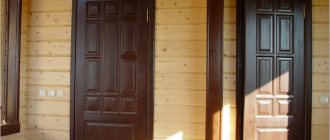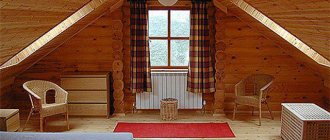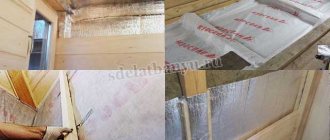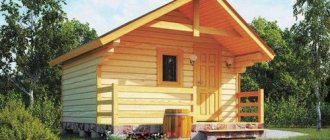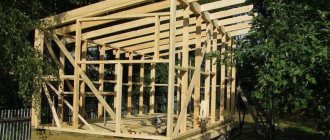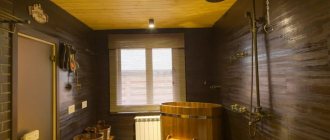Today everyone can afford to have their own steam room on their plot or dacha. But, in addition to the pleasant prospects provided by the bathhouse, a number of questions arise about how to organize the wiring in the bathhouse with your own hands. The main stumbling block in this matter is the high humidity and temperature in the room, classifying it as particularly dangerous according to clause 1.113 of the PUE.
Under such unfavorable conditions, electrical appliances and other elements of the electrical network very quickly break down and fail, and dielectric materials become covered with a layer of conductive moisture. This creates a significant risk of electric shock in emergency situations. Therefore, in order to carry out electrical wiring and other electrical installation work in the bathhouse in accordance with current standards, it is necessary to study the requirements of the PUE.
Requirements according to PUE 7
According to clause 2.1.4 of the PUE, installation of electrical wiring can be carried out in an open or hidden way. This separation of the wiring in the bathhouse is relevant for various types of walls, when it is possible to develop grooves or in the absence of them.
Due to the fact that some rooms are fire hazardous, and wet rooms contain a large amount of condensate, when laying wires in an open or hidden way, all lines must be protected from non-combustible material in accordance with clause 2.1.42 and from moisture in clause 2.1.43 of the PUE.
When wires are placed openly, for example, on wooden walls, the non-combustible lining under them should protrude 10 mm in each direction. It is also necessary to maintain a 10 mm gap from the wire to flammable materials in accordance with clause 2.1.37 of the PUE. For hidden wiring, a fireproof coating is located along the entire length in accordance with clause 2.1.38 of the PUE. But placing wiring in a metal pipe or corrugation is strictly prohibited in accordance with the requirements of 7.1.40 PUE.
In order to maintain safety, all metal structures - housings of lamps, heating stoves, household appliances, etc. must be connected to the protective grounding in the bathhouse wiring, the conductors must be double insulated, the circuit elements must be inaccessible. To protect a person from electric shock, an RCD must be installed in the electrical panel. These measures are specified by the requirements of clauses 1.7.50 and 1.7.51 of the PUE. It should be noted that when lighting devices and other devices are powered with low voltage in accordance with clause 1.7.53, the Electrical Electrical Installation can be carried out without installing protective grounding.
Sources of light
The incandescent lamp power should not exceed 60 W
The choice of lamps for lighting in the bathhouse is the main point. The number of devices, their power and planned location determine how the cable will pass, the size of the pipes for laying the wires and much more. The required materials should be calculated and purchased in advance, maximum - after installing the main frame of the building, before the cladding stage.
Incandescent lamps
Standard and economical option. An ordinary light bulb produces a soft yellowish light that is familiar to the eyes. The main advantages are price and availability. There are more disadvantages - they get very hot, there is a high risk of burns. Only 5% of the energy consumed is used to produce light, the rest is converted into heat. For a steam room it is better to use a different type.
Luminescent
They are considered harmless and are positioned as durable and economical devices. However, using them in baths and steam rooms is dangerous. The inside of the flask is filled with mercury vapor; the glass is not heat-resistant. Such light sources easily break and crack, which is extremely harmful to the health of vacationers.
Some fluorescent lamps emit mercury vapor even during use in steam rooms - high humidity and temperature heat the elements, and dangerous gas is released.
LED
LED lamp 12W E27 warm white A60-12W/WW/E27/FR PLP01WH Uniel
Lighting in bathhouses and steam rooms with LEDs is recognized as the safest and most economical. The cost is a little higher than usual, but it pays off with a long service life and the absolute harmlessness of the elements. Compared to other options, they are brighter with identical power.
What mains voltage should I choose?
Due to the different needs for providing the required level of power, the wiring in the bathhouse can power both lighting fixtures, and then in small spaces, and powerful equipment. Because of this, the type and level of voltage used differs:
- Single-phase network e - used at an average level of load on the wiring in the bath from 1 to 14 kW. In this case, the entire bathhouse is powered from single-phase networks with a voltage of 220 V.
- Three-phase network - used for a wiring load in a bathhouse from 20 to 40 kW, when an electric stove, heated floor and other powerful electrical appliances (water heating boilers, pumps, etc.) are connected to the bathhouse.
- Single-phase low - allows you to power the bathhouse with a safe voltage of 12 V or 36 V, which can be used to illuminate the steam room in the bathhouse without endangering people. Relevant for small baths with low ceilings, in which the only consumer for the leash is the lighting system.
After selecting the voltage level, a wiring diagram is drawn up taking into account the locations of all consumers.
Popular manufacturers
Steel sauna lamp Harvia
The modern market offers a lot of different options - domestic and foreign. The most popular are Finnish companies - Harvia, Tylo. These manufacturers produce a series of special lighting devices for saunas and steam rooms. The price is high, but justified by good performance and long service life.
Products from Linder and Steinel are popular, but have low moisture resistance. Good reviews distinguish TDM Electric products.
Organizing proper and safe lighting in a steam room is not an easy task, but it can be done. You cannot be guided by the principle of “cheap and fast”. The period of their use and the safety of vacationers depend on how accurately all elements of the system are selected.
Circuit design
To draw up a wiring diagram for a bathhouse, you need to decide on the number of connection points to it - lighting devices, sockets for specific equipment, switches, etc. It should be noted that switches, like distribution boxes, are strictly prohibited from being installed in the steam room; they must be located in the locker room or dressing room. Washing is also not suitable for this due to the presence of moisture. The wiring in the steam room cannot be closer to the stove or chimney than 80 cm; these requirements must be taken into account at the design stage.
Figure 1: simple wiring diagram in a bathhouse
Look at the picture, here is one of the simple examples of electrifying a bathhouse. The wiring is connected to two independent terminals, each powering its own socket and a group of lighting lamps. This option will help you calmly leave the room if a short circuit occurs in one of the sections, since there are often no sources of natural light.
If you plan to install specific equipment, for example, a water heating boiler or a washing machine, you should provide a separate line for them in the wiring diagram with a larger cross-section than for a lamp. The washing machine and boiler must be installed in dry conditions. In this case, they should also be shown separately on the wiring diagram.
Precautions when wiring
- All devices and shields must be located in a separate room, which is reliably protected from moisture. In conditions of excessive humidity, structures can fail and rust in a short time. This also applies to plastic devices - there are metal elements inside the structures. There is no need to worry about modern models of shower cabins with built-in water heating. The manufacturer cares about safety, so such devices can also be placed in a washing room.
- The body of the lighting fixtures should be aluminum, and the lampshade should be glass. It is recommended to mount them on the walls, since steam escapes to the ceiling, as a result of which an elevated temperature is established there, which is unacceptable for such devices.
- The transformer device to which the supply voltage will be supplied must be designed for 220 V. It must be installed in a dry place. Only 12 V can be wired through the wall. If 36 V light bulbs are installed, then the permissible voltage will be 42 V.
In the steam room, it is recommended to install 12 V lamps, and place the power supplies for them behind the wall, in other rooms
- If you want to install a washing machine in a steam room, then do not forget that it should be placed in a dry room. You will need to make a separate cable for the electric heater.
- A grounding loop should be laid around the steam room. A circuit breaker or RCD must be installed in the panel. The devices must be located in a container that is protected from moisture.
- If there is a need to install sensors to an electric heater, then you should know that they must be low-voltage and located at a distance of 1 m from the floor base. The control panel is mounted outside the steam room. The heater is installed without sockets.
- It is recommended to mark all elements on the shield with a marker.
Video: types of bath lamps
Selection of wires, switches, lamps
For the completed wiring diagram in the bathhouse, all its components are selected: wires, sockets, switches and lamps. The cable brand is selected in accordance with the conditions in each of the bathhouse rooms (high temperature and humidity).
Depending on the material of the current-carrying conductor, the wiring in the bathhouse can be copper or aluminum, but due to the much better mechanical and electrical parameters, the choice should be made in favor of copper wires. The main parameter for any cable brand is the wire cross-section. The cross-sectional area is selected based on the load connected to the corresponding section of the wiring.
How to choose wires and sockets based on load?
For example, you are going to connect two 100 W light bulbs, plug in a 1 kW electric kettle and a 4 kW electric heated floor. Thus, to calculate the cross-section, add up the power consumption of all consumers P = 0.1 + 0.1 + 1 + 4 = 5.2 kW. To the resulting power value it is necessary to add a 20 - 30% safety margin, for our example we get 6.24 kW. To select a specific cross-sectional value for wiring based on consumer power or electric current, you need to use our calculator or table data:
Table 1: selection of wire cross-section
Look at the table; for a power of 6.24 kW, copper wiring with a core cross-section of 4 mm2 or aluminum wiring of 6 mm2 is suitable. If you have drawn up a power supply diagram with separation of wiring for different consumers, then it is advisable to perform the procedure for calculating the cross-section for each individual section, but the material of the conductor for the wiring must be the same.
The socket, like the wiring, has a certain current carrying capacity. Therefore, the selection of connection points to the mains voltage should be made in accordance with the devices being connected. For example, for a refrigerator it is enough to install a 10 A socket, but for a boiler, depending on the power, you will need 16 or 24 A.
For the steam room
The requirements of GOST R 50571.12-96 establish the following division of the steam room into zones:
Rice. 2: division of steam rooms into zones
Look at the picture, all zones are built in accordance with the location of the stove, be it electric or solid fuel. In relation to laying wiring cables and installing other equipment, these areas have the following requirements:
- The first is intended exclusively for the stove, if it is an electric heater, then the wiring for connecting it;
- The second is considered the most loyal in terms of wiring requirements; no standards are provided for it;
- For the third zone, there are requirements for equipment that must normally withstand temperatures of 125°C or more, and wiring of 170°C or more;
- Only lamps, sensors and regulators can be installed in the fourth zone, but their wiring is selected as for the previous bath zone.
For internal electrical wiring in the steam room, heat-resistant cables should be used, for example, flexible copper RKGM, PVKV, PRKS or PMTK.
Lamps in the steam room must have a metal body to which grounding is connected, a sealed glass shade with a degree of protection of at least IP24. You should not choose models with a plastic body or parts to connect lamps, as they can melt and deform, causing moisture to penetrate inside.
Rice. 3: steam room lamp
For dressing room, locker room, rest room
These premises are characterized by much less stringent requirements for location and wiring characteristics. But they must also comply with all the requirements of the PUE for saunas.
It is also better to use lighting devices that are sealed with a degree of protection of at least IP24, but you can also use models with a polymer body or made of plexiglass, since the temperature in these rooms is much lower. VVGng-LS brand wires are quite suitable for wiring. Sockets must have a protective locking device that prevents the free penetration of moisture from the environment.
Wiring entry into the bathhouse: overhead or underground?
Depending on the method of introducing the cable into a stone or wooden sauna, a distinction is made between overhead and underground installation.
Rice. 4: example of laying an overhead line
The first option has a number of advantages - installation by air is carried out quite quickly and at a lower cost, except in cases where you need to install supports before a wooden building. For overhead installation, it is most important to use self-insulating wire (SIP), the number of cores in which is determined by the choice of three-phase or single-phase electrical wiring. The following distances must be observed:
- Between supports no more than 25 m;
- The height of the SIP cable entry into the building is at least 2.75 m;
- The sag distance of the boom to the ground is not less than 3.5 m.
Due to the fact that underground entry requires the development of a trench for laying the cable, this procedure takes much longer than aerial installation. But when laying the cable entry underground, the line itself is much less exposed to atmospheric factors and wind loads, and therefore lasts much longer.
Rice. 5: example of laying cable underground
When laying an underground input, the following requirements must be met:
- Electrical wiring is inserted through a metal bushing;
- In the trench, the cable is located freely, and not under tension;
Rice. 6: cable in ground - Laying depth of at least 0.8 m;
- An armored grade is used, for example, VBBShV.
In addition to the lengthy installation process, underground cable placement also requires additional measures to protect against accidental damage during excavation work near its route.
Wiring method: open or hidden?
The advantages of open wiring in a bathhouse include simplicity and speed of installation, the absence of labor-intensive preparatory work, and accessibility for repairs. The disadvantages of the open method of laying wiring include its damage and interference with the interior of the bathhouse.
The advantages of hidden wiring include much higher reliability and security of the wires along their entire length. Disadvantages of internal wiring include lengthy preparatory work and wall gating, which is not always possible.
Useful video
A very clear and practical video that talks specifically about bathhouse electrification - we hope that it will be useful to many:
*** Just in case - if you are interested in manual labor - we will recommend you another material indirectly related to electricity in the bathhouse - an article about what types of lampshades for bathhouse lamps are and how to make them with your own hands.
For more materials on wiring, see the sections on lighting and lamps.
Installation and connection step by step
The entire process of installing wiring in a bathhouse can be divided into three main stages. Compliance with the given sequence will allow you to complete the work efficiently and without unnecessary loss of time. Get started with installation:
Distribution panel
- Route the supply inlet to the location where the distribution panel is intended to be installed.
- Before installing the shield, install circuit breakers and RCDs into it according to the operating current ratings. For a bathhouse, the RCD is selected based on the leakage current from 10 to 30 mA.
Rice. 7: dial machines - Install the shield at a height of 1.4 - 1.8 m from the floor level to its cover.
Figure 8: Install the shield - Run the cable to the input machine and route it along separate lines. And in the absence of sectioning, immediately proceed to wiring from the input panel to the consumers.
- Wiring in the bathhouse must be done with a three-wire wire (phase, neutral and ground).
- Connect the protective grounding to the housing to a common PE bus, which is connected to the ground loop.
Sockets and switches
- In places where sockets and switches are installed, develop holes for boxes for indoor installation or install a lining of non-combustible material in wooden baths under open wiring.
Rice. 9: Design the holes - Install the boxes on putty or cement mortar for hidden wiring; for external wiring, you will only need distribution boxes.
Rice. 10: Install the boxes on the cement mortar - All sections of wiring are carried out with solid cores; connection of wires is allowed only in boxes (moisture-resistant clamps) and when connecting sockets, switches and other equipment.
Rice. 11: connection of wires in the box - Install sockets and switches in socket boxes when wiring is hidden or on a non-flammable stand when wiring is open.
Rice. 12: Install the socket
Lighting devices
- Route the wiring to the lighting fixtures.
- Install the lamps in the bathhouse according to the previously drawn up diagram.
Rice. 13: Install the light - Connect the wiring to the socket.
- Ground the housing to a protective PE conductor.
- Install lighting lamps.
Rice. 14: Screw in the lamps - Close the lamps.
Rice. 15: close the lamp
Before starting operation, be sure to check the functionality of all devices in dry conditions. Make sure that the automatic protection system is in working order, this will protect you from the consequences of mistakes even before you start using both the bathhouse itself and the wiring in it.

